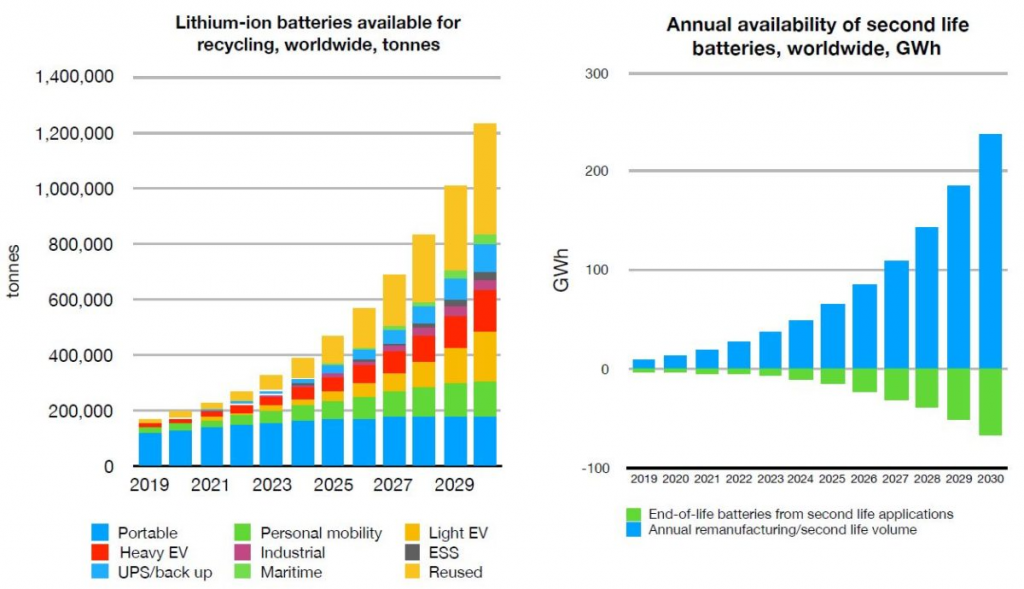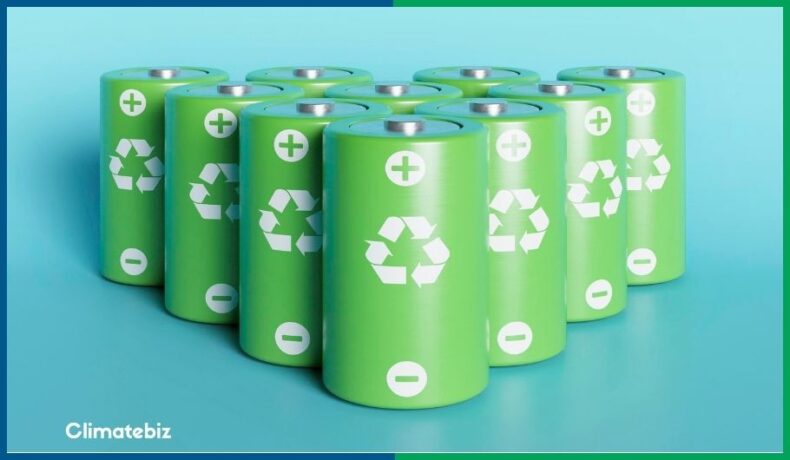The need for rechargeable devices has grown exponentially. Therefore, we can no longer afford to ignore the pressing issue of old lithium batteries and what to do with them. Consequently, it is crucial that we come up with a plan to reuse this technology.
Most battery recycling occurs outside the United States, although this is starting to change. In 2018 around 85,000 metric tons of lithium-ion batteries were recycled in China and South Korea, while approximately 12,000 metric tons were recycled in the United States, Canada, Europe, and Japan combined.
The emissions it takes to send old lithium-ion batteries overseas for recycling almost defeat the purpose of recycling altogether. This calls for a need to expand battery recycling capacity worldwide.
So while these batteries are central to electric vehicles, smartphones, and energy storage systems, like all products, their lifespan is finite. So what can we do with these old lithium batteries once they reach their end?
In this article, we explore the potential for recycling and re-purposing old lithium batteries.
Table of Contents
Are Old Lithium Batteries Reusable?
No, we cannot reuse old lithium batteries directly, so our only option is to recycle them. Not only is this possible, but it’s also crucial to help our world.
In our quest to electrify everything and reduce emissions, we are creating another form of chaos — electronic waste.
Lithium is mined, meaning it’s very resource-heavy. Consequently, we must recycle all old lithium batteries to reduce our environmental impact.
Recycling old lithium batteries has begun to emerge as a potential solution.
Yes, there are concerns that the recycled batteries will be of lesser quality and have shorter lifespans than new batteries. However, emerging research suppresses doubts about the quality of recycled batteries.
The research states that batteries recycled with a new cathode-recycling technique perform comparably to a new battery. In fact, the batteries may even last longer and charge faster.
Furthermore, the research states that one can recycle just the cathode portion of the lithium-ion battery, which is the key to providing voltage to the battery.
Source: Samsung SDI
Previously, the only method known to recycle lithium-ion batteries was to take the whole battery apart and dissolve the entire object in acid.
This results in a powder or gooey mass from which you can take chemical elements. The recovered elements then go through the same manufacturing process as new batteries.
Source: Science Direct
The new cathode recycling technique does not involve as much time and resources; it dissolves the cathode in acid, removes impurities, and adds new elements like nickel and cobalt.
This process keeps the value of the cathode intact instead of dissolving it, as is the case with other recycling methods.
The cathode can now be used in the next battery.
Related Reading: Lithium Battery Cycle Life
What Can you Do With Old Lithium Batteries?
Do not try and disassemble or recycle your old lithium battery on your own. Doing so can lead to serious environmental and health hazards.
This job belongs to the authorized recycling facilities out there that have discovered creative ways to reuse old lithium batteries.
Just because a battery has reached the “end of its life” doesn’t mean it is at the end of its life cycle.
Lithium-ion batteries contain expensive metals like lithium, cobalt, nickel, copper, aluminum, and iron; around 95% of the materials in lithium-ion batteries are reusable.
The most common purpose for battery reuse, especially electric vehicle batteries, is stationary storage applications. An electric vehicle reaches the “end of its life” when its capacity falls below 80%. This means that there is still 80% of usable battery left.

Source: Research Gate
There are several options for a battery’s second life:
- Electric vehicles: vehicle batteries can be recycled by combining the functioning cells to create a refurbished battery. It may even extend the life of the vehicle!
- Energy storage systems: old batteries can be used to store energy from home solar panels.
Some pilot programs have begun emerging to test lithium-ion battery recycling potential. For example, Call2Recycle is looking to partner with electric vehicle companies to recycle old vehicle batteries.
Other lithium-ion battery recycling companies have emerged in the US, including Redwood Materials, Li-Cycle, and Ascend Elements.
Additionally, there has been a push to transition from lithium-ion batteries to battery types that can be taken apart and recycled more sustainably.
Degradable batteries have emerged as a potential solution; these batteries are made with organic substances that can be broken down at the end of the battery’s life cycle.

Source: PV Magazine
Can You Throw Away An Old Lithium Battery?
Don’t even think about throwing your old lithium battery into the trash! Not even in your household recycling bin.
All electronics contain heavy metals that are toxic to humans and the environment when broken down. If you throw your old lithium battery into your household garbage, it will break down and leak chemicals into the environment and groundwater; they can even cause a fire!
At this point, you may be thinking, “isn’t this common knowledge?” yet 95% of global lithium batteries end up in landfills!
What’s more, lithium batteries contain essential elements authorized recycling facilities can remove and reuse.
Related Reading: Lithium Battery Recycling (Where To Take a Dead Battery)
How Long Will Old Lithium Batteries Last?
EV batteries have about a 5-8 year lifespan while leading energy storage systems have a lifespan of about 10 years.
In contrast, battery cells made with upcycled cathode can last up to 50% longer cycle life than batteries made with newly mined materials. They also increase power capacity by 88%.
Recycled Batteries And Slower Degradation
Cathode recycling research has found that the recycled product is more porous than a new lithium-ion battery. This is important because the cathode needs to swell to make room for the lithium ions to enter it. This extra room in the pores keeps the cathode from cracking, which is the main reason for battery degradation.
Old Lithium Battery Example Application
Tesla has an incredible in-house battery recycling program. The company recovers about 92% of its products’ original raw materials for future use.
Not only is Tesla reusing materials from their batteries, but they are also saving $16 million worth of cobalt and $45 million worth of nickel per year.
And yet, lithium-ion battery recycling and reuse techniques and capacity are still becoming more refined.
A recent study on recycling cathodes from retired electric vehicle batteries shows that it is possible to recycle large electric vehicle batteries that have reached the end of their life through day-to-day operations. Cathode upcycling technology successfully delivered a recycled lithium battery that exhibited outstanding results in the full battery tests. The battery even out-performed the pre-upcycled battery.
Related Reading: The Only Battery Size Chart You’ll Ever Need
Final Thoughts
As the demand for electric vehicles, battery storage systems, and smartphones increases, so does the amount of battery waste.
All in all, we need to pay more attention to a lithium-ion battery’s life cycle, from its manufacturing to its recyclability and reusability.
The lithium-ion battery industry needs clear direction when manufacturing its batteries to improve recyclability.
Moreover, instead of focusing on quantity to meet demand, we need to ensure that we can meet demand with available resources; this is where recycling comes in.
Recycling lets us use the bulk of the critical elements found in lithium-ion batteries over again and, as research has shown, can even increase the quality and longevity of the recycled battery.

